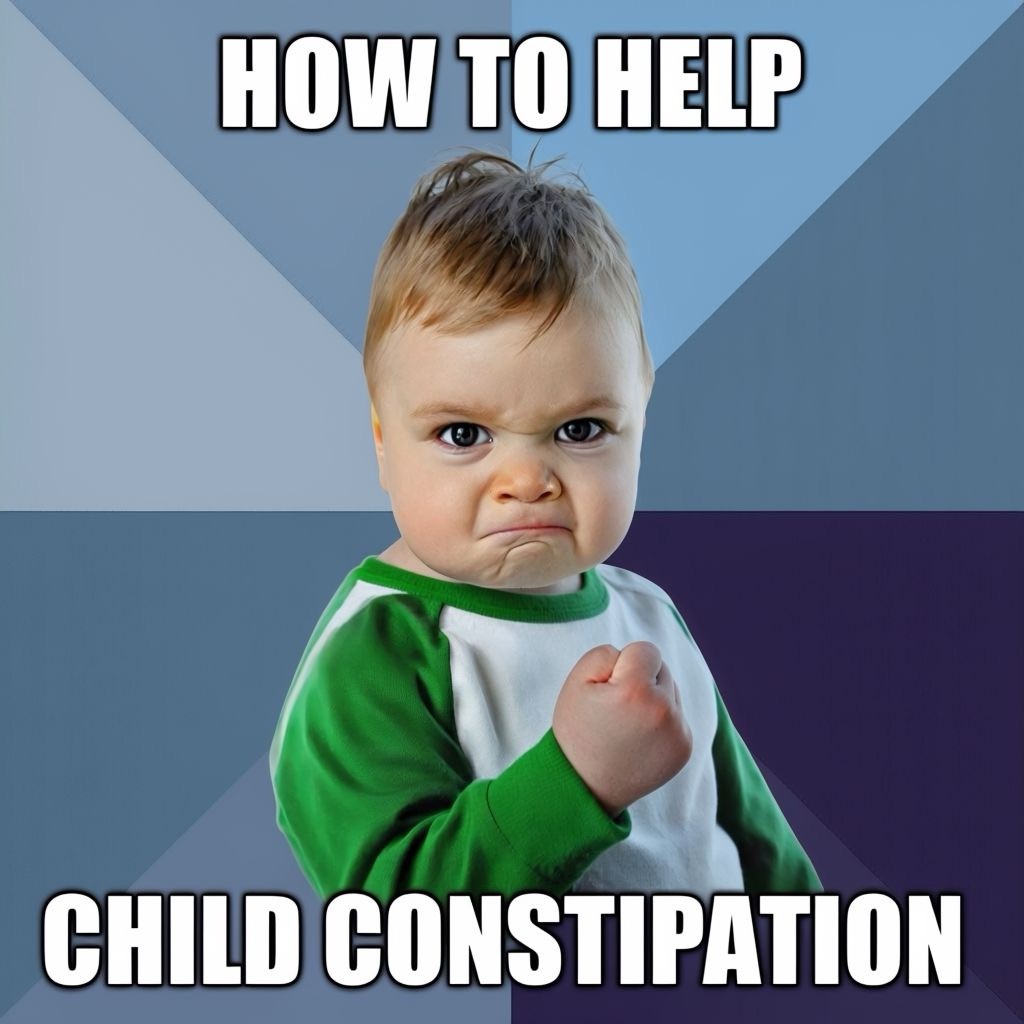
The Struggle with Constipation in Children
As a parent, there’s nothing worse than seeing your child uncomfortable, especially when it comes to something like constipation. It’s tough on them, and it’s tough on us as parents, too. Our youngest, who’s about to turn two, has dealt with constipation on and off since he was very little, and let me tell you—it’s no fun for anyone.
Constipation can completely throw off a child’s day, messing with their appetite and making them cranky and uncomfortable. And the truth is, constipation is pretty common in kids, especially toddlers. It can happen for a variety of reasons, whether it’s something in their diet, a lack of fluids, or just their body still figuring things out.
We’ve had our fair share of those tough moments, trying to figure out how to make our little one more comfortable and get things moving again. If you’re reading this, you’re probably dealing with the same situation, and trust me, I understand how frustrating it can be. But the good news is, there are some simple solutions that can really help get things back on track for your child.
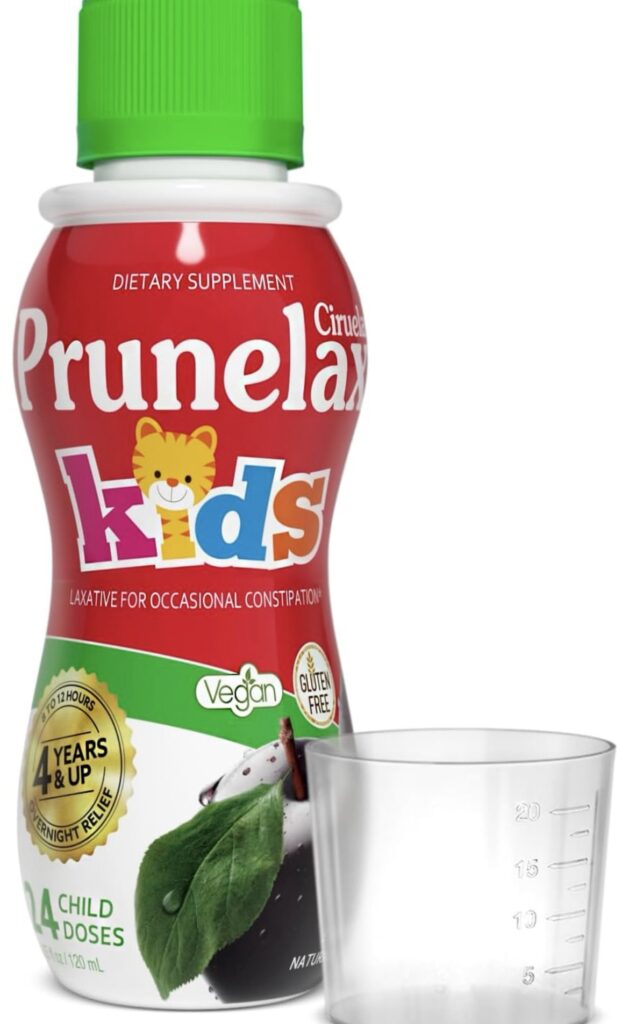
In this article, I’m going to share what I’ve learned from our own experience with constipation, along with some tips that can help you unconstipate your child fast, as well as what to do if the problem keeps coming back. You’ll also learn about some over-the-counter solutions and natural remedies that can make a big difference for both short-term relief and long-term prevention.
Let’s start by talking about some of the quickest ways to help relieve constipation in children. You’re not alone in this, and there are plenty of options to help your little one feel better fast.
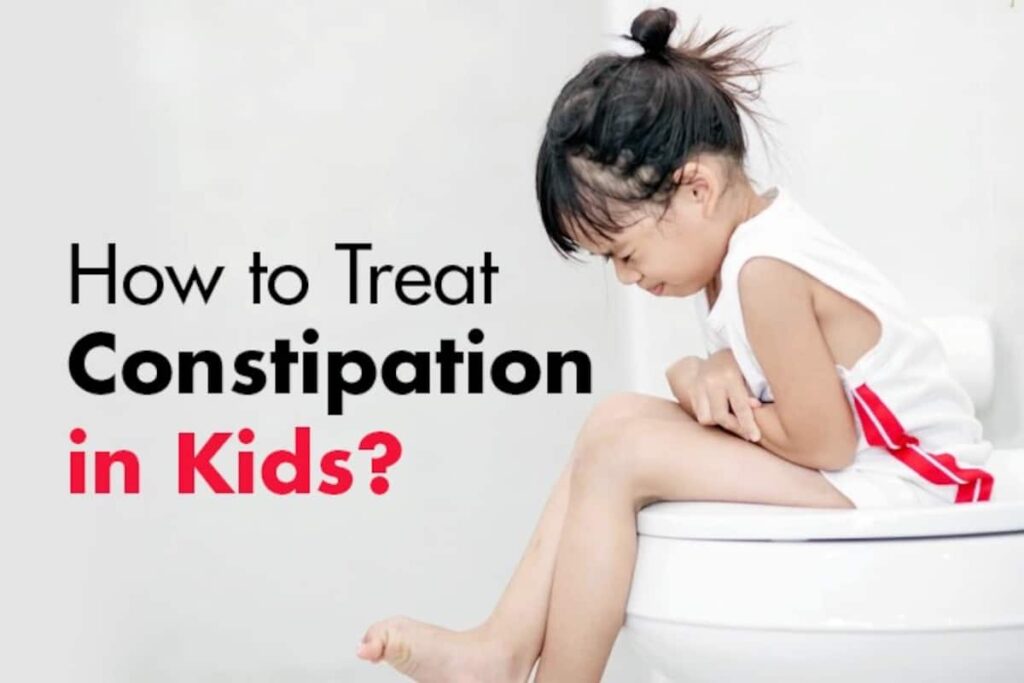
How to Unconstipate a Child Fast
When your child is uncomfortable and constipated, the last thing you want is to sit around waiting for things to get better. Thankfully, there are some quick ways to help get things moving and relieve your child’s discomfort. After dealing with constipation with our little one, we’ve found that a few simple remedies can really make a difference.
1. Increase Water and Fluids
This might sound like a no-brainer, but making sure your child is drinking enough water is one of the easiest and fastest ways to help relieve constipation. Dehydration can make stools harder and more difficult to pass. If your child doesn’t love plain water, you can try offering a bit of diluted juice, like apple or prune juice, which can also help loosen things up naturally.
2. Offer High-Fiber Foods
Fiber is key when it comes to bowel regularity, and there are plenty of kid-friendly options you can offer that may help. Things like apples (with the skin), pears, oatmeal, and whole grains can do wonders. And, of course, don’t forget prunes. I know, prunes aren’t every kid’s favorite, but they can really help soften stools and get things moving.
For adults looking for a natural solution (which might work for older kids too), check out The Best Herbal Tea for Constipation. While it’s not specifically for children, it’s a natural way to promote digestion.
3. Gentle Tummy Massage
Sometimes, a gentle tummy massage can work wonders in helping to ease constipation in children. Using circular motions around their belly button can help stimulate the bowels. I’ve found this to be a calming and effective method, especially when combined with warm baths.
4. Warm Baths
Speaking of baths, a warm bath can help relax your child’s muscles and make it easier for them to go. We’ve had nights where a warm bath was just the thing to help our little one find some relief.
5. Consider a Quick Laxative
If the natural methods aren’t working and your child is still struggling, there are over-the-counter options like Prunelax Ciruelax Regular Strength Liquid Laxative for Kids. It’s a gentle, fast-acting option that can provide relief overnight. Always consult your pediatrician before giving any laxatives, especially for younger kids.
These simple steps have really helped us during those tough moments, and they can work for your child too. Remember, sometimes the smallest adjustments, like upping their water intake or offering fiber-rich snacks, can make all the difference. Now that we’ve covered some quick fixes, let’s talk about what safe options your child can take if constipation keeps coming back.
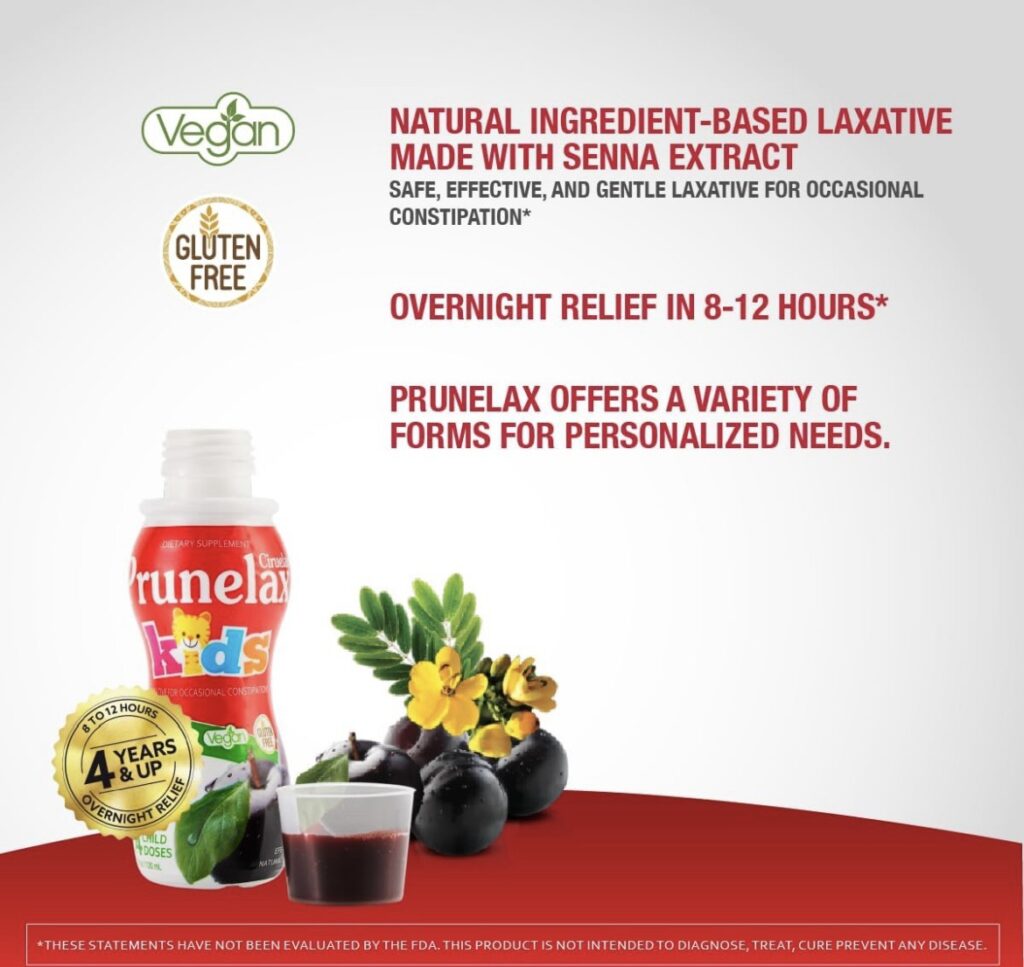
What Can a Child Take for Constipation?
If your child is dealing with recurring constipation, it’s helpful to know what safe, pediatrician-approved options are available. While natural remedies like more fluids and fiber-rich foods are great for regularity, there are times when over-the-counter treatments can be necessary for more stubborn cases. We’ve tried a few options with our little one, and here are some recommendations that can help.
1. Prune Juice and Fiber-Rich Foods
Prune juice is a classic go-to for constipation. It’s mild and effective for many children. Just a small amount, diluted with water if necessary, can help soften stools. You can also offer fruits like pears, apples, and whole grains that are rich in fiber, which helps bulk up the stool and keep things moving.
Fiber is crucial for long-term prevention, so adding in a daily fiber boost can help avoid future issues. Physician’s Choice Kids Probiotic + Prebiotic Fiber Packets are a great option to support digestive health in the long run. They’re easy to mix into your child’s drink or food, and they’re specially designed to promote regularity.
2. Glycerin Suppositories
For more immediate relief, glycerin suppositories are a safe, fast-acting option that you can use under your pediatrician’s guidance. They work by stimulating the bowels directly, encouraging a bowel movement within minutes. It’s not the most comfortable option for kids, but it’s effective when they’re really struggling.
3. Over-the-Counter Stool Softeners
If your child is regularly constipated and you’ve exhausted the usual remedies, your pediatrician may suggest stool softeners like polyethylene glycol (PEG). These products, which are tasteless and easy to mix into your child’s drink, help soften stools without causing cramping. It’s a good middle ground between natural options and stronger laxatives.
4. Liquid Laxatives for Kids
Sometimes, when constipation is more persistent, liquid laxatives can be a quick and gentle option for relief. Prunelax Ciruelax Liquid Laxative is a safe, gentle option specifically designed for kids. It works overnight, so you can give it to your child before bed, and they should see results by morning.
5. Consult Your Pediatrician
Always check with your child’s doctor before giving any medications or laxatives. What works for one child might not be right for another, so it’s important to get personalized advice based on your child’s specific situation.
At the end of the day, the best approach to constipation is often a combination of diet changes, like more fiber, along with plenty of fluids. For long-term digestive health, consider using probiotics, like Physician’s Choice Kids Probiotic + Prebiotic Fiber Packets, to support regularity and avoid future bouts of constipation.
Now that we’ve covered what your child can safely take, let’s explore which laxatives work the fastest for those times when you need immediate relief.
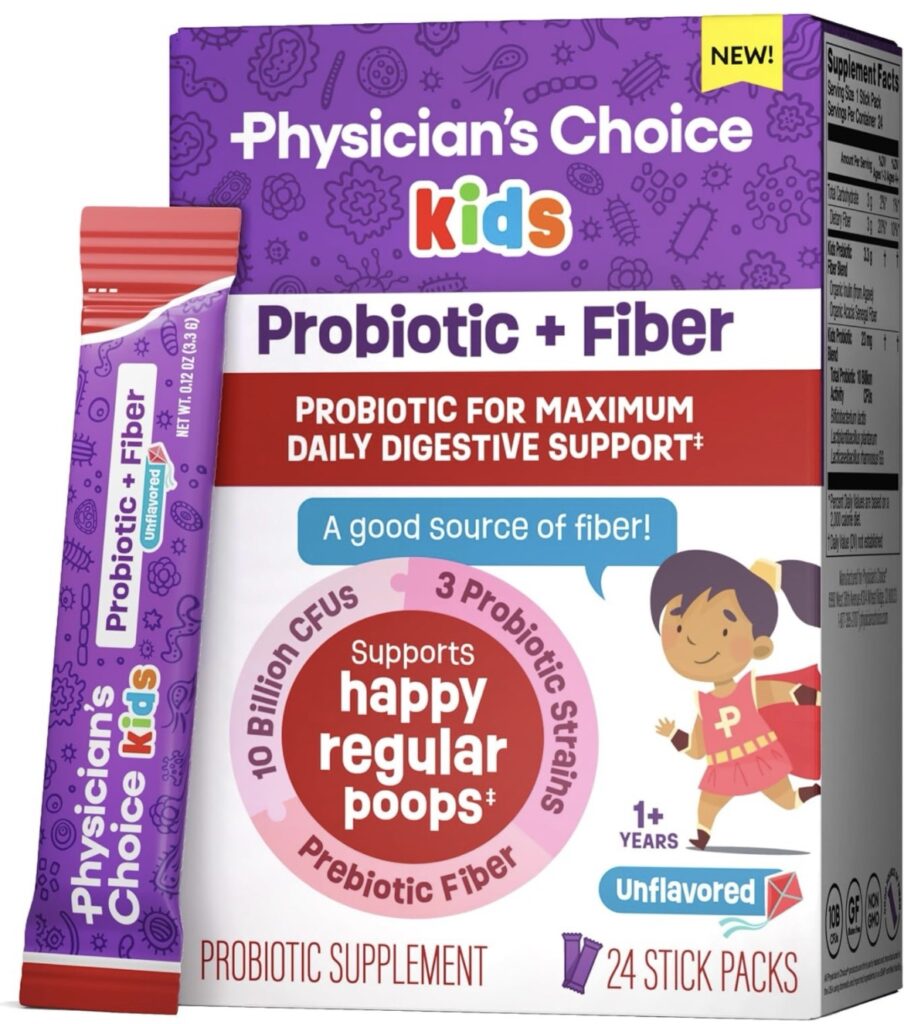
What is the Quickest Laxative for Kids?
When your child is in discomfort from constipation, waiting for relief can feel like an eternity. As a parent, you want something that works quickly but is also safe and gentle for your little one. Fortunately, there are a few fast-acting options that are commonly recommended for kids and can bring relief in a matter of hours or even minutes.
1. Pediatric Glycerin Suppositories
Glycerin suppositories are one of the fastest and most effective options for children. They work by drawing water into the intestines, which softens the stool and stimulates a bowel movement. The best part? They can work within minutes, providing quick relief when your child is really struggling. While inserting a suppository isn’t the most fun for anyone, it’s a safe and proven method for those moments when you need fast results.
2. Prunelax Liquid Laxative for Kids
For a fast-acting, overnight solution, Prunelax Ciruelax Liquid Laxative for Kids is a gentle option that helps relieve constipation by the next morning. This plant-based laxative contains senna, which helps stimulate the bowels naturally and provides relief without causing harsh cramping. It’s designed to be safe and effective for children, and you can expect results within 6 to 12 hours.
3. Polyethylene Glycol (PEG)
Another quick and safe option is polyethylene glycol (PEG), often recommended by pediatricians for kids. It’s an osmotic laxative, meaning it draws water into the colon to soften the stool, making it easier for your child to go. PEG is usually tasteless and can be mixed into any liquid, so it’s easy for kids to take. Results typically happen within 24 hours, but many parents report seeing improvement much sooner.
4. Increasing Fluids and Fiber-Rich Foods
Though not as quick as laxatives, sometimes offering extra fluids and high-fiber foods like prunes, pears, or applesauce can still bring relief in a relatively short amount of time. While these options are better for regular, mild constipation, they can sometimes do the trick if you catch the problem early.
5. Consulting with a Pediatrician
While these options can provide quick relief, it’s always a good idea to consult with your child’s pediatrician before giving any medication or laxative, especially if this is a recurring issue. Your doctor can help recommend the best course of action based on your child’s specific needs and health situation.
Knowing which laxative to use in a pinch can make all the difference when your child is uncomfortable. If you prefer more gentle, plant-based solutions, Prunelax Ciruelax Liquid Laxative for Kids is a great option to have on hand for those times when constipation just won’t budge. And for longer-term relief, incorporating fiber and probiotics into their diet, like Physician’s Choice Kids Probiotic + Prebiotic Fiber Packets, can help keep things moving smoothly.
Next, let’s look at what can happen if constipation goes untreated and what steps you should take if your child’s constipation becomes a recurring issue.
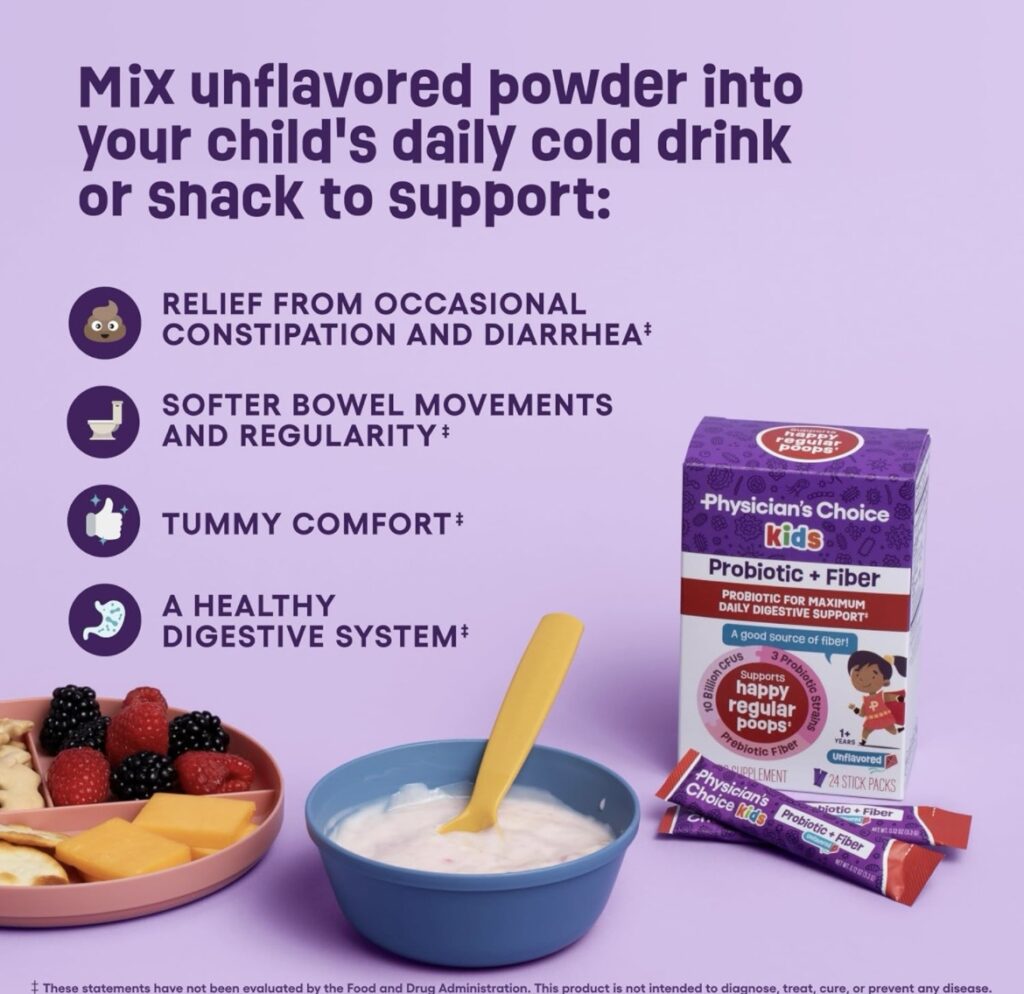
What Happens if a Child Gets Constipated?
Constipation isn’t just uncomfortable for your child—it can also lead to some bigger issues if it goes untreated for too long. While the occasional bout of constipation is normal, chronic or severe constipation can cause complications that require medical attention. So, what can happen if a child gets constipated, and when should you be concerned?
1. Short-Term Discomfort
In the short term, constipation leads to discomfort, making your child irritable and less likely to eat properly. They may feel bloated, have trouble going to the bathroom, or complain about a tummy ache. You might also notice them straining or avoiding the bathroom altogether, which only makes things worse.
2. Hard, Painful Stools
If your child is constipated for a few days, their stool can become hard and dry, making it even more difficult (and painful) to pass. This creates a cycle where the fear of pain makes them hold it in even longer, leading to a more severe blockage. This is when pediatric stool softeners or a gentle laxative like Prunelax Ciruelax Liquid Laxative for Kids can really help.
3. Appetite Loss
When a child is constipated, they often lose their appetite. Their stomach might feel full, and eating can make them feel even more uncomfortable. This lack of appetite can lead to nutrition issues, especially if the constipation persists for several days.
4. Impact on Other Body Functions
Chronic constipation can also affect other body functions. For example, some kids may start wetting the bed again or experiencing daytime accidents because the pressure from backed-up stool impacts their bladder control. This is a sign that things are getting serious and need to be addressed. Check out Managing Nighttime Incontinence in Kids for more tips if this is something you’re dealing with alongside constipation.
5. Fecal Impaction
In more severe cases, untreated constipation can lead to fecal impaction, where stool gets stuck in the colon or rectum and becomes too hard to pass without medical intervention. This can cause severe pain, abdominal swelling, and sometimes even vomiting. If your child’s constipation lasts more than a few days or if they start showing signs of impaction (like abdominal pain and bloating), it’s time to see a doctor.
6. Behavioral Changes
A child dealing with chronic constipation might also show behavioral changes, like being more irritable, avoiding activities they usually enjoy, or being reluctant to go to the bathroom. These behavioral shifts are often tied to the discomfort they’re feeling and the fear of painful bowel movements.

What to Do
If your child is frequently constipated, it’s important to address the underlying issue. Increasing fiber in their diet, making sure they stay hydrated, and possibly using a gentle laxative like Prunelax Ciruelax Liquid Laxative for Kids can help manage the immediate problem. For ongoing support, consider adding Physician’s Choice Kids Probiotic + Prebiotic Fiber Packets to their daily routine to support healthy digestion and regular bowel movements.
If you notice signs that constipation is becoming a more serious issue—like constant pain, swelling, or appetite loss—it’s a good idea to consult your pediatrician to explore treatment options.
Next, we’ll talk about when you should seek medical help and what signs to watch for that indicate your child’s constipation may need professional intervention.

When to Seek Help for Your Child’s Constipation
While constipation is usually something that can be managed at home, there are times when it’s necessary to get medical help. As parents, we know our kids best, and sometimes we can just sense when something isn’t quite right. If your child’s constipation becomes frequent or severe, it’s important to pay attention to certain red flags that might mean it’s time to consult a doctor.
1. Constipation Lasting More Than a Few Days
If your child has been constipated for more than three or four days and natural remedies like extra fluids, fiber-rich foods, or a gentle laxative like Prunelax Ciruelax Liquid Laxative for Kids aren’t helping, it’s time to reach out to your pediatrician. Prolonged constipation can lead to discomfort, and if left untreated, it could result in more serious complications.
2. Severe Abdominal Pain or Swelling
While mild cramping is normal with constipation, severe abdominal pain or noticeable swelling can be signs of something more serious, like fecal impaction or another digestive issue. If your child is experiencing significant pain, doesn’t want to eat, or has a swollen belly, it’s essential to get medical advice.

3. Vomiting
Vomiting, especially when paired with constipation, can indicate a bowel obstruction or impaction. If your child is constipated and starts throwing up, don’t wait—contact a healthcare provider immediately.
4. Blood in the Stool
If you notice blood in your child’s stool, this could be a sign of straining too hard, a tear in the rectum, or something more serious. While small amounts of blood from straining can happen, larger amounts or consistent blood in the stool should be evaluated by a doctor right away.
5. Fever
Fever is a sign that your child’s body is fighting something off, and when combined with constipation, it could indicate an infection or other underlying condition. A fever along with constipation is a clear signal that you need to seek professional help.
6. Recurring Constipation
If your child is regularly constipated, this could be a sign that their diet, fluid intake, or lifestyle needs adjusting, or there could be an underlying medical issue. Chronic constipation should always be discussed with your pediatrician, who can help you figure out the best long-term solutions. For some, adding probiotics like Physician’s Choice Kids Probiotic + Prebiotic Fiber Packets can help maintain regular bowel movements and support digestive health.
7. When to Visit Urgent Care
In some cases, urgent care might be the best option, especially if your child’s constipation comes on suddenly and is accompanied by severe pain, vomiting, or other concerning symptoms. If you’re unsure about the next step, a quick trip to urgent care can provide answers and relief for your child. For more guidance on when to seek urgent medical help, take a look at Urgent Care for Kids for tips on navigating unexpected health situations.
When it comes to constipation, knowing when to seek help is key to avoiding more serious issues. Trust your instincts—if something doesn’t feel right, don’t hesitate to reach out to your child’s healthcare provider. Constipation might be common, but it’s always better to be cautious, especially when your little one’s comfort and health are at stake.
Up next, we’ll cover some long-term tips and strategies for preventing constipation in children to help avoid these issues in the future.
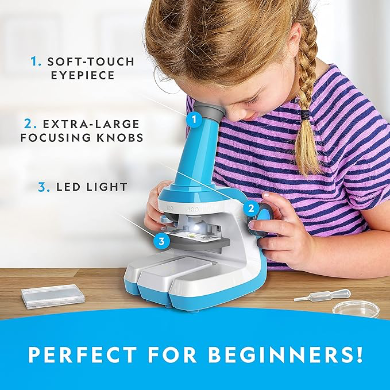
Long-Term Prevention Tips for Constipation in Children
Once your child has found relief from constipation, the next step is to ensure it doesn’t keep coming back. Long-term prevention is all about making small changes in their daily routine that can promote healthy digestion and regular bowel movements. Over time, I’ve learned that consistency is key when it comes to keeping our little one’s tummy happy and healthy.
1. Increase Fiber in Their Diet
One of the most important steps to preventing constipation is to make sure your child is getting enough fiber. Fiber helps add bulk to the stool, making it easier to pass. Foods like whole grains, apples, pears, and berries (like blueberries) are great choices to include in their meals. You can also sneak in some extra fiber with snacks like oatmeal or whole-grain crackers.
- Tip: Incorporating fiber into your child’s diet on a daily basis will help promote long-term regularity. If you’ve ever noticed how blueberries affect your child’s digestion, check out this interesting read on Why Blueberries Change Your Toddler’s Poop for more insight.
2. Keep Them Hydrated
Water is essential for preventing constipation, as it helps keep stools soft and easier to pass. Make sure your child is drinking plenty of fluids throughout the day, especially if they’re active or the weather is hot. Encourage them to choose water over sugary drinks, and offer water-rich foods like watermelon or cucumbers to boost their hydration.
3. Encourage Daily Physical Activity
Movement is just as important for digestion as diet and hydration. Kids who are physically active tend to have healthier bowel movements. Whether it’s playing outside, running around, or engaging in sports, daily physical activity helps keep their digestive system moving too.
4. Establish a Regular Bathroom Routine
Children can sometimes resist going to the bathroom, especially if they’ve had painful bowel movements in the past. To help prevent constipation, it’s important to establish a regular bathroom routine. Encourage your child to take bathroom breaks, especially after meals, to help develop healthy bowel habits.
- Tip: Make sure your child feels comfortable going to the bathroom when they need to, without rushing or holding it in. Keeping potty time low-pressure and consistent can help avoid future issues.
5. Consider Probiotics
Probiotics can play an important role in promoting gut health and preventing constipation. They help balance the bacteria in the digestive tract, which can lead to more regular bowel movements. Physician’s Choice Kids Probiotic + Prebiotic Fiber Packets are an easy and kid-friendly option that can be mixed into their food or drink to help support long-term digestive health.
6. Monitor for Any Signs of Recurring Constipation
Even with a good routine, it’s important to keep an eye on your child’s bowel habits. If constipation starts to become a regular occurrence, consider talking to your pediatrician to make sure there aren’t any underlying health issues. Catching the signs early can help prevent the problem from escalating.
7. Overall Health and Development
Maintaining a balanced and healthy lifestyle is key to preventing not just constipation but a wide range of health issues. From keeping your child active to ensuring they’re getting the right nutrients, all aspects of their health play a role in their digestive system. For overall growth and development, including vision, check out The Remarkable Journey of Vision Development in Babies for insights on how their physical health is connected to their broader well-being.

Preventing constipation in children takes a mix of dietary changes, hydration, routine, and sometimes a little extra help from supplements or probiotics. By making these small but impactful changes, you can help your child avoid future discomfort and keep their digestive system running smoothly.
Constipation may be common, but with the right approach, you can ensure your child feels healthy, comfortable, and ready to tackle the day without digestive worries.
As an Amazon Associate we earn from qualifying purchases through some links in our articles.



